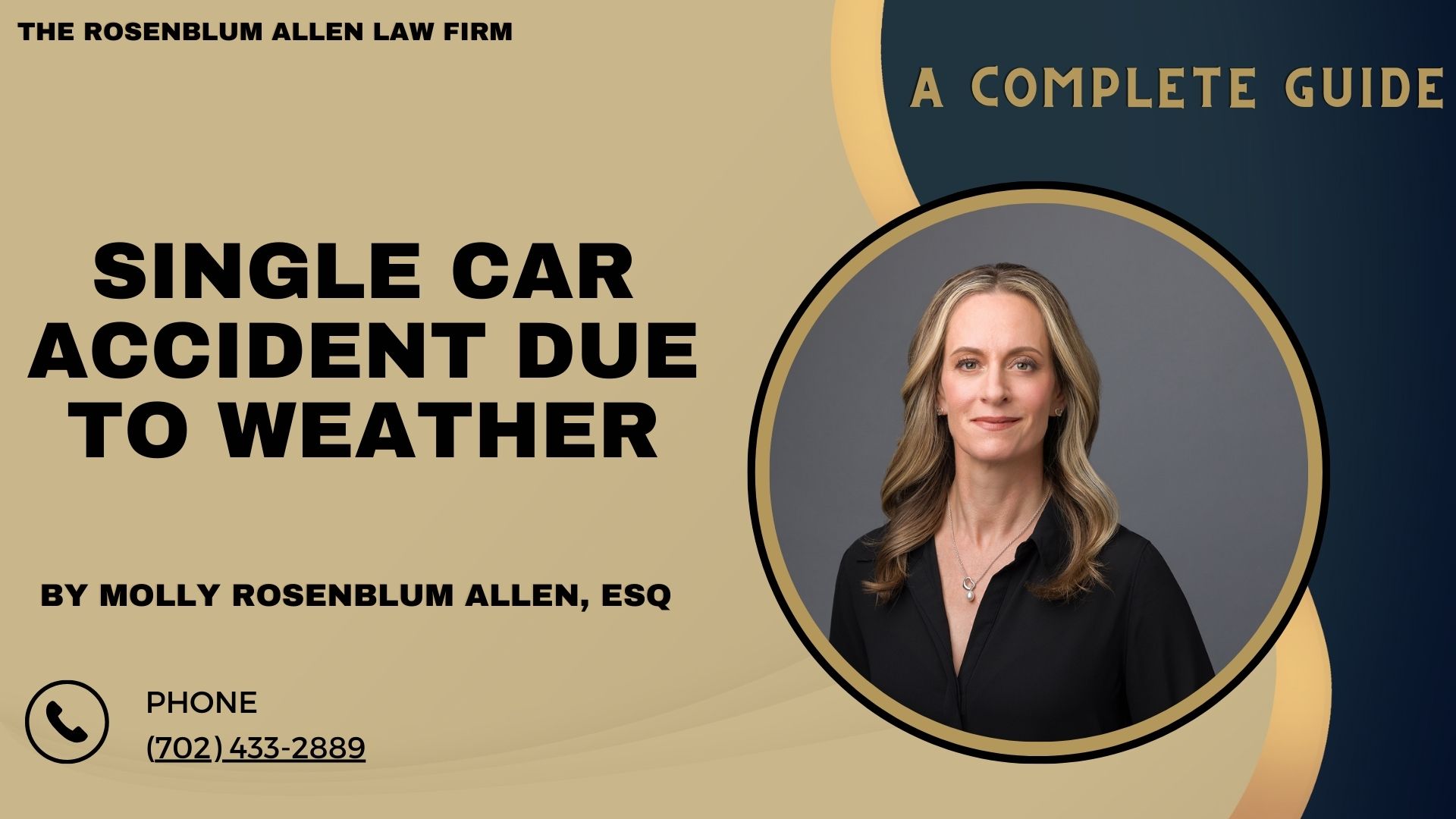When you’re driving down a lonely road and suddenly find yourself skidding off the pavement, it’s a terrifying experience. Single-car accidents due to weather are more common than you might think. They can happen to anyone, anywhere, at any time.
 Defining a Single-Car Accident
Defining a Single-Car Accident
A single-car accident is exactly what it sounds like – involving just one vehicle. No other cars are involved. These accidents can range from a simple fender bender to a catastrophic rollover. Picture this: You’re driving home late at night. The rain is pouring down. Suddenly, your car hydroplanes, and you end up in a ditch. That’s a single-car accident.
The Role of Weather in Car Accidents
Weather plays a huge role in road safety. It’s like Mother Nature throwing a curveball at drivers. From rain-slicked roads to blinding snowstorms, weather conditions can turn a routine drive into a dangerous journey. Did you know? Weather-related crashes account for nearly 21% of all vehicle crashes in the United States. That’s a staggering number when you think about it.
Common Weather Conditions Leading to Single Car Accidents
Let’s dive into the weather conditions that often lead to these solo mishaps on the road. Each type of weather brings its own set of challenges for drivers.
Rain and Wet Roads
Rain might seem harmless, but it’s one of the most dangerous weather conditions for drivers. It’s like nature makes the roads extra slippery and treacherous.
Hydroplaning
Have you ever felt your car suddenly lose contact with the road? That’s hydroplaning. It happens when a layer of water builds up between your tires and the road surface. Suddenly, you’re not driving – you’re floating! Here’s what happens during hydroplaning:
- Your tires lose traction on the road
- Steering becomes ineffective
- Braking distance increases dramatically
Reduced Visibility
Rain doesn’t just make the roads slick – it also makes it harder to see. Imagine trying to peer through a waterfall while driving. That’s what heavy rain can feel like. Reduced visibility leads to:
- Difficulty seeing other vehicles
- Challenges in judging distances
- Increased reaction time to obstacles
Snow and Ice
Winter weather brings its own set of challenges. Snow and ice transform familiar roads into treacherous obstacle courses.
Slippery Road Surfaces
Ice is like nature’s version of a slip-and-slide but much less fun when you’re behind the wheel. Even a thin layer of ice can dramatically reduce your tires’ grip on the road. Consider these facts about icy roads:
- It takes up to 10 times longer to stop on ice compared to dry pavement
- Black ice is hazardous because it’s nearly invisible
- Even four-wheel drive vehicles can lose traction on ice
Reduced Traction
Snow piling up on the road isn’t just a nuisance – it’s a serious safety hazard. It’s like trying to drive through a field of marshmallows, but a lot less tasty and dangerous. Effects of reduced traction in snow:
- Wheels can spin without moving the vehicle
- Steering becomes less responsive
- Braking distances increase significantly
Remember, knowledge is power when it comes to weather-related single-car accidents. Understanding these conditions means you’re already taking the first step towards safer driving in challenging weather.
Fog
Fog is like nature’s way of throwing a blanket over the world. It can turn a familiar road into an eerie, unfamiliar landscape.
Impaired Visibility
Driving in fog is like trying to navigate through a cloud. Everything becomes hazy and indistinct. It’s not just challenging – it can be downright dangerous. Here’s what you might experience in foggy conditions:
- Difficulty seeing road signs and markings
- Challenges in spotting other vehicles until they’re very close
- Struggle to determine where the road ends and the shoulder begins
Misjudging Distances
In fog, your depth perception goes haywire. That car ahead of you? It may be closer than you think. The turn you need to make? It could sneak up on you faster than expected. Common mistakes in foggy conditions:
- Following too closely to the vehicle in front
- Overestimating the distance to intersections or exits
- Misjudging the speed of oncoming vehicles
Strong Winds
Remember to underestimate the power of the wind. It’s not just bad hair days – strong winds can seriously affect your driving.
Vehicle Stability Issues
Imagine walking in a straight line while someone constantly pushes you sideways. That’s what driving in strong winds can feel like. Effects of wind on vehicle stability:
- Difficulty maintaining your lane
- Increased risk of rollover for high-profile vehicles
- Sudden gusts can push your car unexpectedly
Debris on the Road
Wind doesn’t just affect your car directly. It can turn everyday objects into dangerous projectiles. Potential road hazards in windy conditions:
- Fallen tree branches
- Loose construction materials
- Garbage or other lightweight items blown onto the road
Extreme Heat
We often think about rain and snow, but extreme heat can be just as dangerous for drivers.
Tire Blowouts
Hot roads can be harsh on your tires. It’s like trying to run a marathon on scorching pavement – eventually, something’s got to give. Factors contributing to heat-related tire blowouts:
- Underinflated tires
- Overloaded vehicles
- Excessive speed on hot roads
Engine Overheating
Your car’s engine works hard enough as it is. Add extreme heat to the mix, and you have a recipe for potential disaster. Signs your engine might be overheating:
- Temperature gauge creeping into the red zone
- Steam or smoke coming from under the hood
- Unusual smells, like burning rubber or hot oil
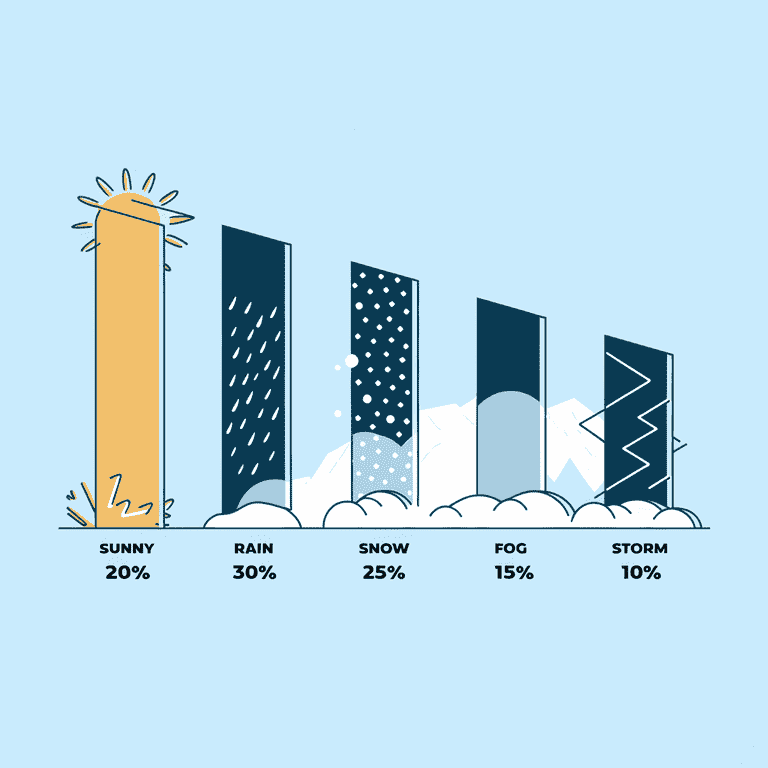
Statistics on Single-Car Accidents Due to Weather
Numbers don’t lie. Let’s take a look at some eye-opening statistics about weather-related single-car accidents.
Frequency of Weather-Related Accidents
Weather plays a more significant role in road safety than you might think. It’s not just a minor inconvenience – it’s a significant factor in many accidents. Key statistics:
- Over 1.2 million weather-related crashes occur each year in the U.S.
- This accounts for approximately 21% of all vehicle crashes
- About 70% of weather-related crashes occur on wet pavement
Fatality Rates
Sadly, weather-related accidents aren’t just about fender benders. They can have serious, sometimes fatal, consequences. Sobering facts:
- Nearly 5,000 people are killed annually in weather-related crashes
- Wet pavement contributes to approximately 76% of weather-related fatalities
- Winter conditions (snow/sleet) account for about 17% of weather-related fatalities
Understanding Liability in Weather-Related Single Car Accidents
Who’s to blame when the weather turns nasty and you find yourself in a single-car accident? It’s not always as clear-cut as you might think.
Driver Responsibility
As a driver, you’re not just a passenger in your vehicle. You’re the captain of your car-shaped ship, responsible for navigating through whatever Mother Nature throws your way.
Duty of Care in Adverse Weather
Ever heard the phrase “drive to the conditions”? That’s what duty of care is all about. It means adjusting your driving to match the weather, even if it means going slower than the speed limit. Examples of duty of care in bad weather:
- Reducing speed in rain or snow
- Increasing following distance on slippery roads
- Using headlights in fog or heavy rain
Negligence and Recklessness
Sometimes, accidents happen despite our best efforts. Other times, they’re the result of poor choices. Negligence is like forgetting to tie your shoelaces before a race – an oversight that can lead to a fall. Actions that might be considered negligent in bad weather:
- Driving too fast for the conditions
- Failing to maintain proper tires for winter driving
- Ignoring weather warnings
Potential Third-Party Liability
Believe it or not, sometimes the driver isn’t the only one who might be held responsible for a weather-related single-car accident.
Road Maintenance Issues
Imagine you’re skiing down a slope, and suddenly, there’s a vast pothole hidden under the snow. Not fair, right? The same principle applies to poorly maintained roads in bad weather. Potential road maintenance issues:
- Inadequate drainage leading to flooding
- Failure to salt or plow snowy roads
- Lack of warning signs for known hazardous areas
Vehicle Defects
Your car is your partner in safe driving. But what if your partner lets you down? Sometimes, vehicle defects can contribute to accidents, especially in challenging weather conditions. Examples of vehicle defects that could contribute to accidents:
- Faulty windshield wipers
- Defective tires
- Malfunctioning anti-lock braking systems
Insurance Considerations
Ah, insurance. It’s like an umbrella—you hope you never need it, but you’re glad you have it when it rains.
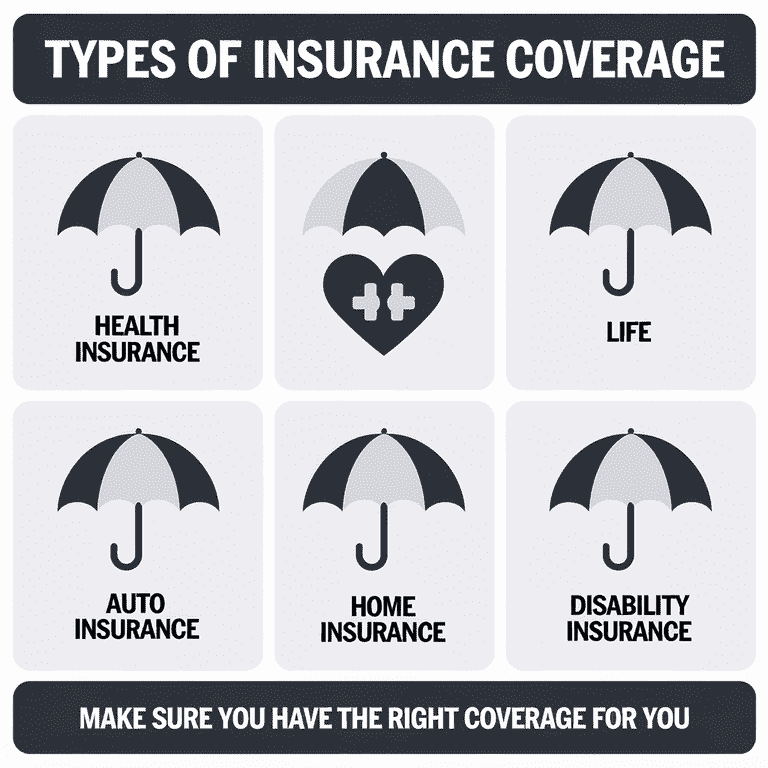
Coverage for Weather-Related Accidents
Not all insurance policies are created equal. Some might leave you high and dry when it comes to weather-related accidents. Types of coverage that might help in weather-related accidents:
- Comprehensive coverage (for damage from falling objects or flooding)
- Collision coverage (for damage from hitting another object)
- Personal injury protection (for medical expenses regardless of fault)
Legal Aspects of Single Car Accidents Due to Weather
The law doesn’t take a rain check when the skies open up, and the roads get slick. Let’s dive into the legal side of weather-related single-car accidents.
Proving Fault
In a single-car accident, proving fault is straightforward. But add weather to the mix, and things can get as murky as a foggy night. Critical factors in proving fault:
- Driver’s actions (speed, attention, etc.)
- Road conditions and maintenance
- Vehicle condition
- Weather warnings and advisories
Remember, just because of the terrible weather doesn’t automatically absolve you of responsibility. The law expects you to adjust your driving to the conditions.
Comparative Negligence
Sometimes, the fault isn’t black and white – it’s more like fifty shades of gray. That’s where comparative negligence comes in. How comparative negligence works:
- The court determines the total amount of damages
- They assign a percentage of fault to each party involved
- Your compensation is reduced by your percentage of fault
For example, if you’ve found 30% at fault for driving too fast in the rain, you might only receive 70% of the total damages awarded.
Statute of Limitations
Time waits for no one, and neither does the law. The statute of limitations is like a ticking clock on your right to file a lawsuit. Essential points about statutes of limitations:
- They vary by state (typically 1-6 years for car accidents)
- The clock usually starts ticking from the date of the accident
- Missing the deadline can mean losing your right to sue forever
Don’t let time slip away. If you’re considering legal action after a weather-related accident, acting promptly is crucial. Navigating the legal aspects of weather-related single-car accidents can feel like trying to steer through a blizzard. However, understanding these key points can help you chart a more straightforward course through the legal landscape.
Prevention and Safety Measures
An ounce of prevention is worth a pound of cure, especially regarding weather-related accidents. Let’s explore how you can stay safe when Mother Nature decides to throw a tantrum on the roads.
Vehicle Preparation
Your car is your trusty steed in the battle against bad weather. But like any good knight, it needs proper armor and maintenance to keep you safe.
Tire Maintenance
Think of your tires as your car’s shoes. You wouldn’t run a marathon in flip-flops, would you? Essential tire maintenance tips:
- Check tire pressure monthly (remember the spare!
- Rotate tires every 5,000-8,000 miles
- Replace tires when the tread depth reaches 4/32 inch (or sooner)
- Consider winter tires for snowy climates
Brake System Checks
Your brakes are like your car’s parachute. When you need them, you need them. Brake maintenance essentials:
- Listen for unusual noises (squealing, grinding)
- Feel for vibrations when braking
- Check brake fluid levels regularly
- Replace brake pads when they’re worn
Windshield Wiper Maintenance
Windshield wipers are your car’s eyelashes, batting away rain and snow. Could you keep them in top shape? Wiper care tips:
- Replace blades every 6-12 months
- Clean wipers with windshield washer fluid
- Never use wipers on a dry or icy windshield
- Consider winter wiper blades for snowy climates
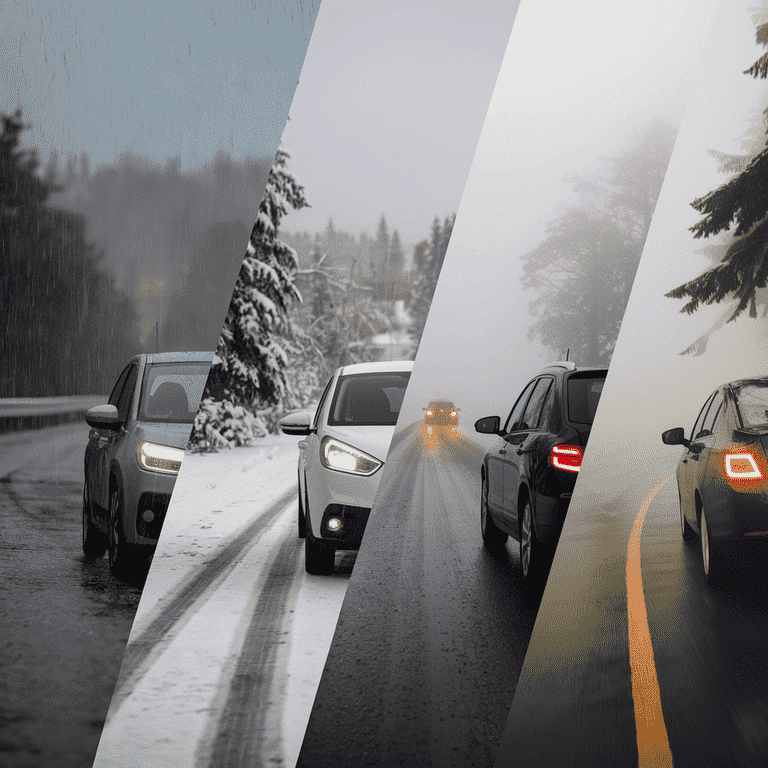
Driving Techniques for Hazardous Weather
When the weather turns nasty, it’s time to channel your inner race car driver (minus the speed).
Reducing Speed
Slow and steady wins the race, especially in bad weather. Here’s why slowing down matters:
- Increases reaction time
- Reduces stopping distance
- Lowers risk of hydroplaning
- It gives you more control over your vehicle
Increasing the Following Distance
Give yourself some breathing room. In bad weather, the three-second rule becomes the six-second rule. Benefits of increased following distance:
- More time to react to sudden stops
- Better visibility of road conditions ahead
- Reduced risk of rear-end collisions
- Less spray from other vehicles in wet conditions
When to Avoid Driving
Sometimes, the bravest thing you can do is decide not to drive.
Assessing Weather Conditions
Before you hit the road, take a moment to check the forecast. It’s like looking both ways before you cross the street but for your entire journey. Weather red flags:
- Severe thunderstorm warnings
- Blizzard conditions
- Flash flood alerts
- Tornado warnings
Alternative Transportation Options
When the weather outside is frightful, consider these delightful alternatives:
- Public transportation (buses, trains)
- Ride-sharing services
- Working from home (if possible)
- Postponing non-essential trips
Remember, it’s better to arrive late than not arrive at all. Your safety is worth more than any appointment or deadline. By preparing your vehicle, adjusting your driving techniques, and knowing when to stay off the roads, you’re not just avoiding accidents – you’re mastering the art of weather-wise driving. Stay safe out there, road warriors!
Steps to Take After a Weather-Related Single Car Accident
Oops! Despite your best efforts, you’ve been in a weather-related single-car accident. Don’t panic. Here’s your roadmap to handling the situation like a pro.
Ensuring Personal Safety
Your health is your wealth, especially after an accident. Here’s what to do first:
- Take a deep breath. Staying calm helps you think clearly.
- Check yourself for injuries. Even minor aches could be signs of something serious.
- If you’re able, turn on your hazard lights. It’s like waving a flag to other drivers.
- Assess your surroundings. Is it safe to stay in the car, or should you carefully exit?
Remember, if you’re in doubt about moving, stay put. It’s better to be safe than sorry.
Documenting the Accident Scene
Think of yourself as a detective at a crime scene. Your mission? Gather evidence! Key things to document:
- Take photos of your vehicle from multiple angles
- Capture images of the road conditions and weather
- Note the exact time and location of the accident
- Please write down your recollection of events while they’re fresh
Pro tip: Use your smartphone’s voice recorder to narrate what happened if writing is difficult.
Long-Term Impact of Weather-Related Single Car Accidents
The storm may have passed, but its effects can linger. Let’s look at the potential long-term consequences of your weather-related mishap.
Physical and Emotional Recovery
Healing isn’t just about mending bones. It’s a journey for both body and mind. Physical recovery might involve:
- Medical treatments and therapy
- Adjusting daily routines during recovery
- Potential long-term lifestyle changes
Emotional recovery could include:
- Dealing with anxiety about driving in bad weather
- Processing trauma from the accident
- Rebuilding confidence behind the wheel
Remember, it’s okay to seek help. Support is available, whether it’s a doctor for your body or a therapist for your mind.
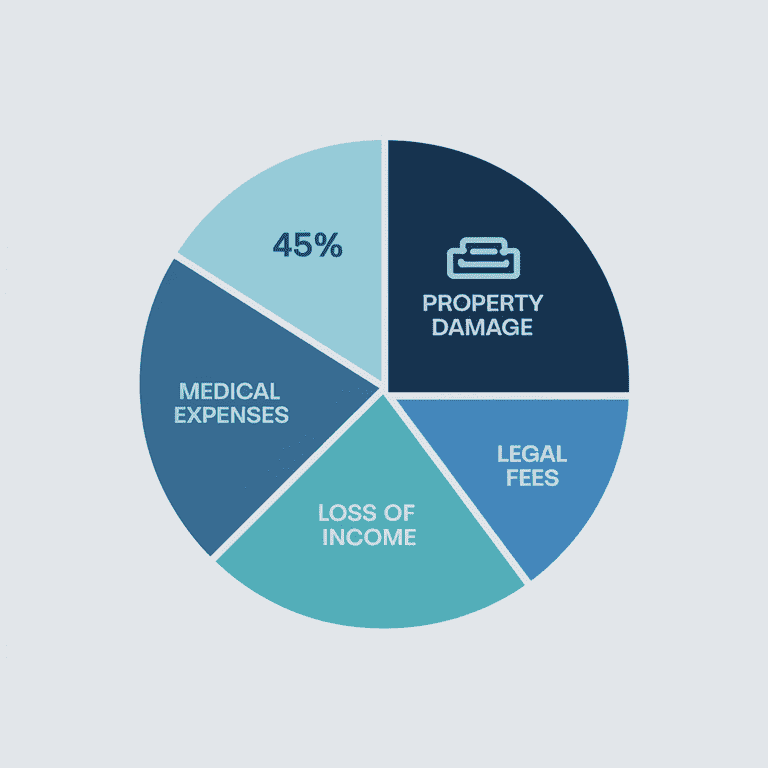
Financial Consequences
Accidents can be like unwelcome house guests for your wallet. They show up unexpectedly and can stick around for a while. Potential financial impacts:
- Medical bills (immediate and ongoing)
- Vehicle repair or replacement costs
- Lost wages from time off work
- Increased insurance premiums
Pro tip: Keep all receipts related to your accident. You never know what might be reimbursable.
Insurance Premium Effects
Brace yourself. Your insurance premiums might be going on a roller coaster ride. Factors affecting your premiums post-accident:
- The severity of the accident
- Your driving history before the incident
- Your insurance company’s policies
- Whether you were found at fault
Technological Advancements in Weather-Related Accident Prevention
Welcome to the future of driving! Technology is like a superhero, swooping to save us from weather-related accidents. Let’s explore some of these high-tech guardians of the road.
Advanced Driver Assistance Systems (ADAS)
ADAS is like having a co-pilot who never gets distracted or tired. These systems are your extra set of eyes and reflexes on the road. Popular ADAS features:
- Automatic Emergency Braking (AEB): Stops your car when it senses an imminent collision
- Lane Departure Warning: Alerts you if you’re drifting out of your lane
- Adaptive Cruise Control: Maintains a safe distance from the car ahead, even in changing weather
Fun fact: Some ADAS can detect rain on your windshield and automatically turn on your wipers. It’s like magic, but it’s science!
Weather Forecasting and Route Planning Apps
Remember when we used to check the weather by looking out the window? Those days are long gone. Now, your smartphone is your meteorologist and navigator. Top features of weather and route planning apps:
- Real-time weather updates along your route
- Alerts for severe weather conditions ahead
- Suggestions for safer alternative routes
- Integration with your car’s navigation system
Pro tip: Set up weather alerts on your phone before long trips. It’s like having a weather radar in your pocket!

Breaking It All Down
Driving in challenging weather is about more than just getting from point A to point B. It’s about arriving safely with a story rather than an accident to report. So, take a deep breath the next time you’re behind the wheel, the skies open up, or the fog rolls in. Remember what you’ve learned. You’re not just a driver – you’re a weather warrior, ready to face whatever Mother Nature throws your way. Stay safe out there, road champions. The weather might be unpredictable, but your response doesn’t have to be. Happy (and safe) driving!

Frequently Asked Questions
Q: How does altitude affect the likelihood of weather-related single-car accidents?
A: Higher altitudes can increase the risk of weather-related accidents due to more frequent and severe weather changes. You may encounter sudden fog, icy conditions, or strong winds at higher elevations more often. Additionally, thinner air at altitude can affect vehicle performance, potentially impacting your ability to respond to sudden weather changes.
Q: Are certain types of vehicles more prone to weather-related single-car accidents?
A: Yes, some vehicles are more susceptible to weather-related accidents. High-profile vehicles like SUVs, vans, and trucks are more vulnerable to strong winds. Rear-wheel drive vehicles often struggle more in snowy or icy conditions than front-wheel or all-wheel drive vehicles. Sports cars with low ground clearance may be at higher risk of flooding.
Q: How do I handle encountering a tornado while driving?
A: If you encounter a tornado while driving, do not try to outrun it. Instead:
- Seek shelter in a sturdy building immediately
- If no building is available, exit your car and lie flat in a low-lying area, protecting your head
- Avoid seeking shelter under bridges or overpasses, as these can create dangerous wind tunnels
- Stay away from trees or vehicles that could be blown onto you
Q: Can weather-related wear and tear on my vehicle lead to single-car accidents?
A: Weather can cause long-term wear on your vehicle, potentially leading to accidents. For example:
- Extreme temperature fluctuations can cause tire pressure changes and accelerate tire wear
- Salt used on winter roads can corrode vehicle components
- UV rays from intense sunlight can degrade rubber and plastic parts over time
- Regular maintenance checks prevent weather-related wear from compromising your vehicle’s safety.
Q: How does fatigue from driving in challenging weather conditions impact accident risk?
A: Driving in challenging weather conditions can be mentally and physically exhausting. This fatigue can:
- Slow your reaction times
- Impair your decision-making abilities
- Reduce your ability to concentrate
- Increase the likelihood of falling asleep at the wheel
- It’s essential to take regular breaks when driving in challenging weather and to avoid driving when overly tired.
Q: Are there any specific techniques for driving through standing water?
A: When driving through standing water:
- Drive slowly and steadily
- Use the center of the road, where it’s typically the highest
- Don’t stop in the water; maintain momentum
- Test your brakes immediately after exiting the water
- If the water is more profound than the bottom of your doors, find an alternate route
Q: How do I adjust my car’s systems for optimal performance in extreme cold?
A: In extreme cold:
- Use a lower-viscosity oil as recommended by your car manufacturer
- Keep your gas tank at least half full to prevent fuel line freezing
- Use winter-grade windshield washer fluid
- Consider using fuel additives to prevent fuel line freezing
- Ensure your battery is in good condition, as cold weather reduces battery performance
Q: What should I do if caught in a dust storm while driving?
A: If caught in a dust storm:
- Pull off the road as far as possible
- Turn off all lights, including emergency flashers
- Set the emergency brake and take your foot off the brake pedal
- Stay in the vehicle with seatbelts fastened
- Wait for the storm to pass before resuming your journey

Glossary
Advanced Driver Assistance Systems (ADAS): A group of electronic technologies that assist drivers in driving and parking functions, often through a safe human-machine interface.
All-Wheel Drive (AWD): A drivetrain that employs a front, rear, and center differential to power all four wheels of a vehicle.
Black Ice: A thin, transparent layer of ice on road surfaces, often invisible to drivers, causing extremely slippery conditions.
Comparative Negligence: A principle of tort law that reduces a plaintiff’s recovery by the percentage of fault attributable to them in an accident or injury.
Comprehensive Coverage: This is optional auto insurance coverage that helps pay to replace or repair your vehicle if it’s stolen or damaged in an incident that’s not a collision.
Duty of Care: A person or organization’s responsibility or legal obligation to avoid acts or omissions that could reasonably be foreseen to cause harm to others.
Hydroplaning: When a vehicle’s tires lose contact with the road surface and skim along a film of water, resulting in a loss of steering, braking, and power control.
Liability: The state of being legally responsible for something, often used in the context of fault in an accident.
No-Fault Insurance: A type of auto insurance in which insurers pay for their policyholders’ losses regardless of who was at fault in the accident.
Negligence: Failure to take proper care in doing something, often leading to harm or damage.
Statute of Limitations: A law that sets the maximum time after an event within which legal proceedings may be initiated.
Traction: The friction between a drive wheel and the road surface or the tire’s ability to “grip” the road.
Traction Control: An electronic system designed to prevent loss of traction of driven wheels when accelerating on slippery surfaces.
Underinflated Tires: Tires with less air pressure than recommended can lead to poor handling, increased wear, and a higher risk of blowouts.
Visibility: The degree to which the weather allows objects to be seen, often impacted by fog, heavy rain, or snow.
Weather-Related Crashes: Traffic accidents that occur in adverse weather conditions such as rain, sleet, snow, fog, severe crosswinds, or blowing snow/sand/debris.
Windshield Wipers: Devices that remove rain, snow, ice, and debris from a vehicle’s windshield.
Winter Tires: Also known as snow tires, these are tires designed for use in snow, slush, or icy conditions.

Additional Resources for You
As you navigate through the complexities of dealing with weather-related single car accidents, remember you’re not alone. Our lead attorney, Molly Rosenblum Allen, Esq., has meticulously crafted additional resources to assist you in your time of need. Whether you’re facing challenges from a personal injury, a car accident, or more specific cases like motorcycle accidents, wrongful death, truck accidents, drunk driving incidents, or slip and fall accidents, we have a wealth of knowledge ready for you. Here are some valuable resources:
For comprehensive support and legal advice related to personal injuries in Las Vegas, explore our detailed guide at Las Vegas Personal Injury Attorney. This resource is designed to help you understand your rights and the steps to take following an injury.
If you’ve been involved in a car accident, find effective legal assistance and essential information at Las Vegas Car Accident Attorney. Our focus is on helping you navigate the legal process with ease.
Motorcycle accidents can be particularly challenging. For specialized support in these cases, visit Motorcycle Accident Lawyer Las Vegas, where you’ll find resources tailored to the unique aspects of motorcycle claims.
In the painful event of a wrongful death, we offer compassionate and skilled legal guidance. Learn more at Wrongful Death Lawyer Las Vegas to understand how we can support you through this difficult time.
For accidents involving trucks, which often result in complex legal challenges, our Truck Accident Attorney Las Vegas page provides specialized legal insights and assistance.
Drunk driving accidents are distressingly common and can have devastating consequences. For those affected, our Las Vegas Drunk Driving Accident Attorney resource offers dedicated support and legal advice.
Slips, trips, and falls can occur anywhere, often leading to significant injuries. Our Las Vegas Slip and Fall Attorney page is an essential resource for anyone who has suffered from such an accident and needs effective legal guidance.
Molly Rosenblum Allen, Esq. and the entire team at The Rosenblum Allen Law Firm are here to provide you with the support, knowledge, and legal expertise you need during challenging times. Our resources are designed to offer comprehensive guidance and advocacy to ensure your rights are protected and you receive the compensation you deserve.

Outside Resources for You
National Highway Traffic Safety Administration (NHTSA): NHTSA provides a wealth of information on vehicle safety, accident prevention, and driving tips for all types of weather conditions. Visit NHTSA’s homepage for comprehensive resources.
American Bar Association (ABA): The ABA offers resources on finding legal help, understanding your legal rights, and accessing public resources related to legal issues. Their homepage, American Bar Association, is a good starting point.
Insurance Information Institute (III): For detailed information on insurance coverage, claims processes, and how to handle accidents from an insurance perspective, the Insurance Information Institute’s homepage is invaluable.
National Weather Service (NWS): The NWS provides up-to-date weather alerts and safety tips for dealing with adverse weather conditions. Check out the National Weather Service homepage for the latest weather information.
Federal Emergency Management Agency (FEMA): FEMA offers advice on preparing for and responding to emergencies, including those caused by severe weather. Visit the Federal Emergency Management Agency homepage for resources on emergency preparedness.
American Association for Justice (AAJ): This organization supports the legal advocacy community, providing resources for those seeking justice in personal injury and other legal matters. The American Association for Justice homepage can guide you through finding support for your case.
SafeKids Worldwide: Focused on preventing injuries in children, SafeKids Worldwide offers resources for parents to ensure their children’s safety in and out of vehicles. Explore the SafeKids Worldwide homepage for child safety tips.

A Special Message from Our Lead Attorney, Molly Rosenblum Allen, Esq

Dear Reader,
Thank you so much for taking the time to explore our resources. I hope you found the info insightful and helpful. You are navigating a complex situation. We know legal issues can be tough. This is especially true for accidents and injuries.
At The Rosenblum Allen Law Firm, we commit to giving you support. We will also give you expertise and guidance. You need these during this time. Molly Rosenblum Allen, Esq., leads our team. We dedicate ourselves to working tirelessly on your behalf. Our goal is to achieve the best outcome for your case.
If you are ready to discuss your situation more and see how we can help you, please call us at (702) 433-2889. We do not offer a free consultation. But, we commit to tailoring great legal services to meet your needs.
Your trust in us is something we value deeply, and we look forward to the opportunity to serve you.
Warm regards,
Molly Rosenblum Allen, Esq.
The Rosenblum Allen Law Firm

